This fermented honey garlic is the perfect thing to make to boost your immune system! Both honey and garlic have strong medicinal benefits, so you’ll want to have this delicious home remedy on hand for cold and flu season.
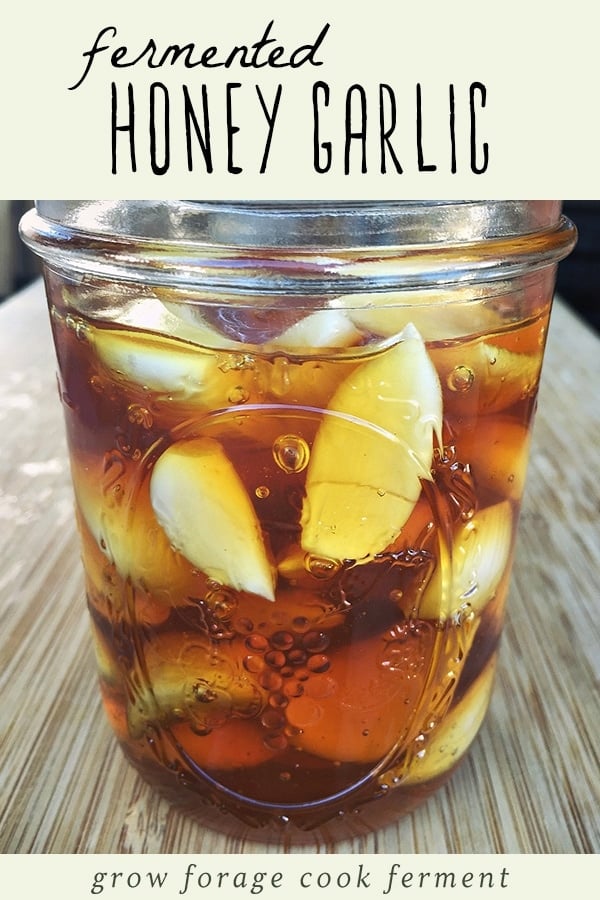
Want to save this post for later?
Fermenting Garlic in Honey
I’m really excited to share this post with you! Fermented honey garlic is something I’ve been wanting to try for a very long time, ever since I first read about it on the Killer Pickles blog.
I usually reserve my honey for mead making, but using it for other ferments intrigued me. Don’t ask me why I haven’t done it until now, because it’s the easiest thing in the world!
This tasty fermented garlic in honey can be used for many things, as good food and good medicine. Honestly though, I like to just eat it as is!
Fermented Honey Garlic Recipe
Making fermented honey garlic is so easy, it hardly needs a recipe!
Prepare the Garlic
The hardest and most time consuming part is prepping all of the garlic. Whatever size jar you use, you’ll want to fill it about 1/2-3/4 full of peeled garlic.
The quickest and easiest way to prep garlic is to place the side of a chef’s knife on top of a single clove and then give it a firm whack with the palm of your hand.
Don’t do it too hard, as you don’t want to crush the garlic, but just enough to lightly bruise the it. This will make it easy to peel, and will also release a bit of the garlic juice.
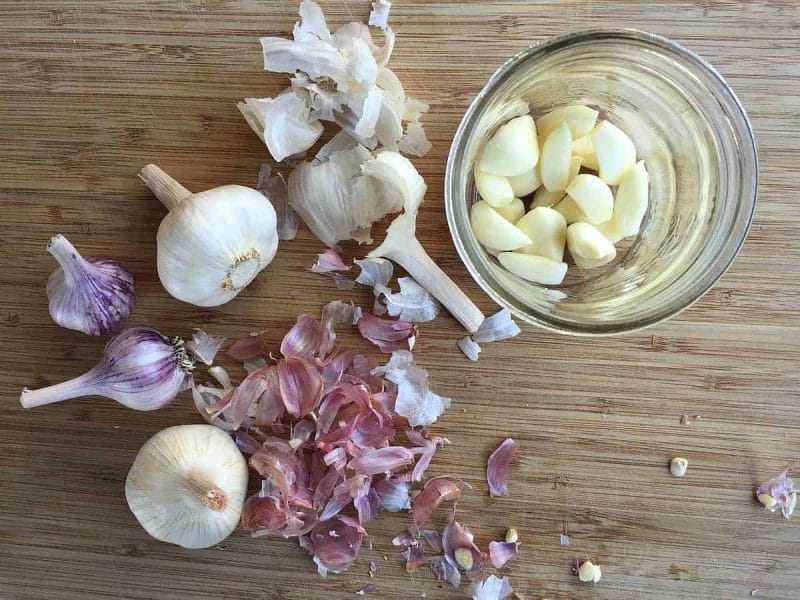
Add the Honey
Once you have enough garlic in your jar, pour in some raw honey to cover it. The garlic will probably float a bit and that’s ok.
It’s important to use raw honey to make fermented garlic in honey, as it will still have all the bacteria and wild yeast that is necessary for fermentation.
When liquid is added to honey, it jump starts the fermentation process. The small amount of juice from the garlic will create just enough liquid for fermentation to happen.
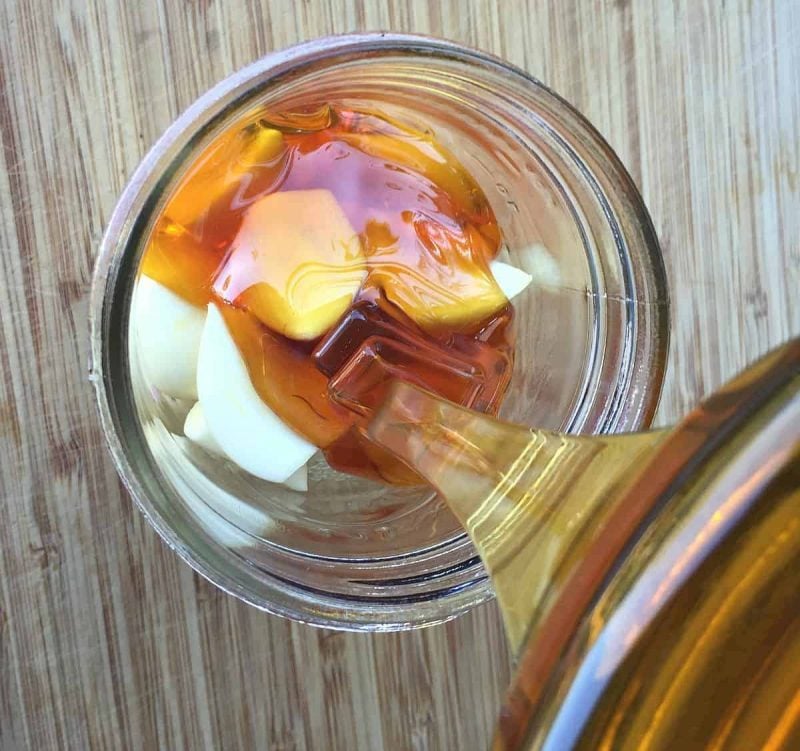
Cover and Flip
Cover the jar loosely with a lid to let the gasses escape, and put it in a dark place to ferment.
It’s a good idea to put a plate or something similar underneath the jar as it’s fermenting, as it will likely bubble up a bit and a little honey could possibly drip out.
It’s also important to gently turn the jar over every day or so, or whenever you think about it, to make sure that all of the garlic stay coated with honey.
Screw the lid on tightly before you do this! Then return it to it’s upright position and re-loosen the lid.
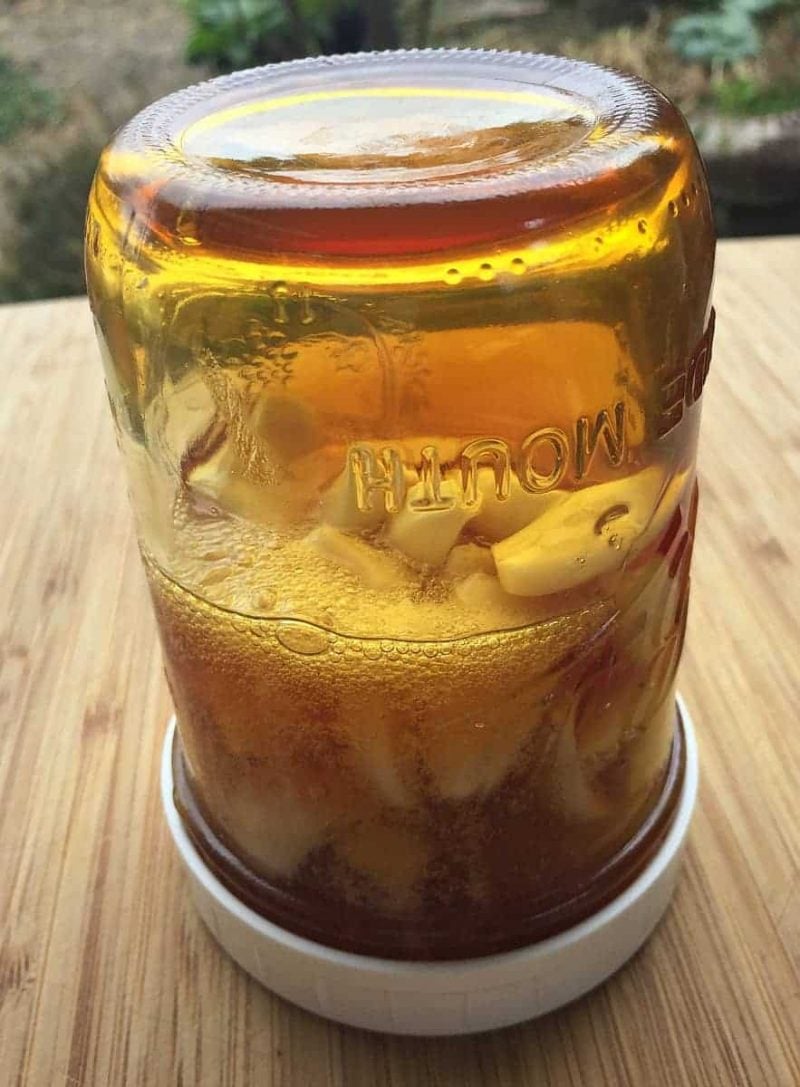
In a few days to a week you will notice some bubbles forming on the surface of the honey. Hooray!
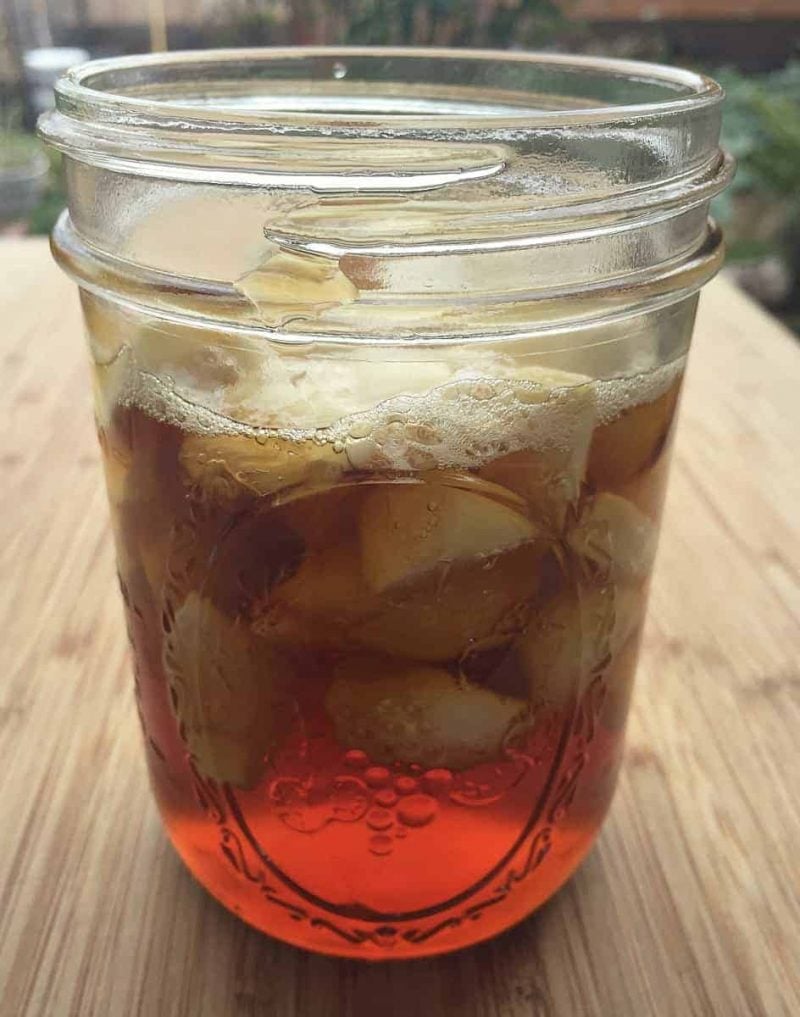
The honey garlic will ferment for about a month, but you can eat it at any time during the process.
The flavor will continue to develop over time, the garlic will mellow, and the honey will become much runnier.
Occasionally the garlic cloves turn a blue or green color due to a reaction during the fermentation process. While it may be a bit alarming, it is not harmful and the honey garlic can still be used.
Honey garlic will store well in a cool place for many months, or even a year or longer! I’ve kept some for over two years and it is still good.
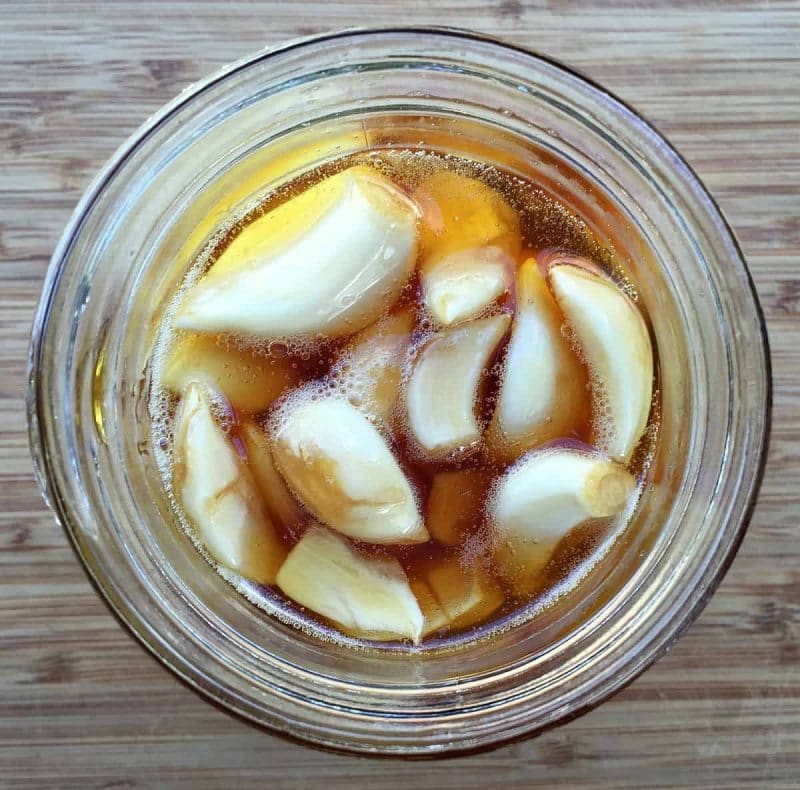
Using Fermented Honey Garlic
Now, how do you use this fermented honey garlic? That’s a good question, and it can be used in a variety of ways.
Both garlic and honey have strong medicinal properties, so it makes sense to use it as an immune booster or if you feel a cold or flu coming on.
Pop a whole garlic clove, or take a spoonful of honey (or both!).
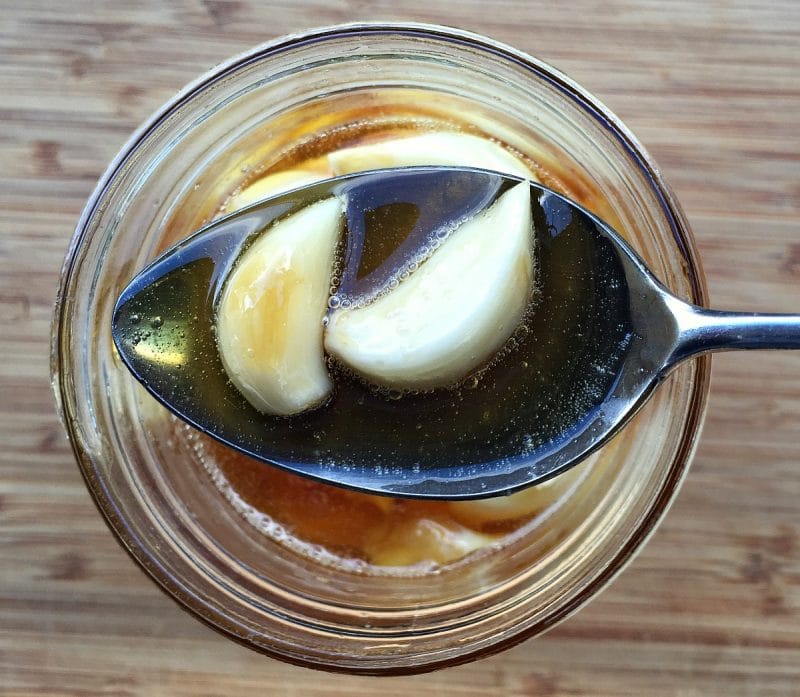
As you can probably imagine, honey garlic also makes a wonderful food!
It’s a natural in marinades and sauces, and would make a really tasty glaze for meats or veggies. Basically anything where you would normally use honey and garlic together!
Is Botulism a Concern in Honey Garlic?
I get this question a lot about fermented honey garlic! The short answer is no, botulism is really not a concern in this type of ferment.
While botulism can happen in garlic and oil preparations without added acidity, the fermentation process that happens here makes it very unlikely.
Raw honey is acidic, and while it can carry botulism spores (which is why it is not recommended for babies under 1 year), the level of acidity stops them from reproducing, which is what causes botulism.
If you are concerned about it, use a pH test strip. Botulism spores can’t reproduce with a pH of less than 4.6. Honey is usually around 3.9, but that can vary between brands.
If the pH is too high, add a splash of raw apple cider vinegar to add more acidity and retest. This is generally not needed, but I did want to mention it.
Honey garlic should not be given to babies under one year of age.
I really hope you make this yummy honeyed garlic! It’s super easy, and great to have on hand. I have a feeling it’s going to become a staple in our house!
Have you ever made fermented honey garlic? How do you use it?
More Fermented and Infused Honey Recipes
Enjoy these other recipes that showcase fermented and infused honey!
- Fermented Honey Cranberries
- Fermented Elderberry Honey
- Herbal Infused Honey
- Lilac Flower Infused Honey
Fermented Honey Garlic
Equipment
Ingredients
- 1 cup whole garlic cloves peeled and slightly crushed
- 1 cup raw honey or more, as needed to cover garlic
Instructions
- Place the peeled garlic cloves into a wide-mouth pint sized mason jar. Add enough honey to completely cover the garlic cloves. Make sure they are coated with honey.
- Place the lid on the jar loosely, then tuck into a dark place.
- Every day or so, tighten the lid on the jar and flip it upside down to coat the garlic cloves with honey. Loosen the lid again when you return it to the upright position.
- Within a few days to a week, you should see small bubbles start to form on the surface of the honey.
- The honey garlic will ferment for about a month, but you can eat it at any time. The flavor will continue to develop over time, the garlic will mellow, and the honey will become much runnier.
- Store in a cool place for many months or even a year, if not longer.
Notes
- It’s important to use raw honey for this recipe, as it has all of the bacteria and wild yeast that is necessary for fermentation.
- The small amount of juice from the garlic will create just enough liquid for fermentation to happen.
- It’s a good idea to put a plate underneath the jar during fermentation, as it will likely bubble up and a little bit of honey could possibly drip out.
- Occasionally the garlic cloves turn a bluish or greenish color during the fermentation process. While it may be a bit alarming, it is not harmful and the honey garlic can still be used.
- If you are concerned about botulism, use a pH test strip. Botulism spores can't reproduce with a pH of less than 4.6. Honey is usually around 3.9, but that can vary between brands.
- If the pH is too high, add a splash of raw apple cider vinegar to add more acidity and retest. This is generally not needed, but I do want to mention it.
- Honey garlic should not be given to babies under one year of age.

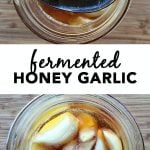
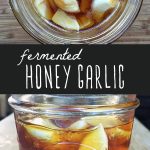
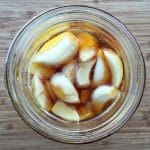

I just made this monday. I popped it right in the fridge, do you think that’s ok?
It won’t ferment in the fridge. You’ll need to let it come up to room temperature and follow the instructions in the recipe to ferment your honey garlic for up to a month.
Can you store it in the fridge after the fermentation process?
It’s best to store it at room temperature in a cool, dark pantry or cabinet.
I made mine last week using another recipe. But if i follow yours it looks like i didnt put enough garlic. Can i just open the jar and add more? The lid has been on tight and i havent “burped” it because the other recipe didnt say anything. It it now a total waste?
Yes, it should be fine to add more garlic.
I used a food chopper and minced the garlic, will this still work?
Yup!
I did this last week based off instagram reels I had seen – but the majority of those “burp” the jar once a day. I just saw your method where you leave the lid on loose. So each day as I burp the jar a HORRENDOUS AWFUL mega garlic smell escapes that stinks up the whole house! Now I’m afraid of just leaving the lid on “loose”, as it will stink up the inside. I may just continue to burp but take the jar outside for that process. Thoughts? Defintely want to avoid a big stinky honey mess. I’ll add my cloves are turning blue/green and there are lots of bubbles, so I know the fermentation method is working.
You can do it however you like.
For some reason, I decided to chop my garlic into 1/2” pieces so we can eat them lol did I screw it all up or will the process still work?
TIA!
It’ll still work.
I used garlic from Sam’s that is prepeeled and refrigerated. Is that ok? Or should u use fresh garlic ?
It may work? If it’s not organic, there’s a chance it won’t ferment though!
I made 3 months ago. Just opened it up and tried it. Oh my heavens. I think it’s better the longer it sits. I’ve used this on chickens to roast and on roasts-covered with honey garlic and a dry rub that I want. Fantastic combination roast.
So glad your fermented garlic came out so well. Enjoy!
My honey was a little solidified when I started the process, will that effect anything?
It may take longer to ferment. You could always place the jar in a bowl of warm water (not hot) and help the honey liquify.
I made this on 9/6 and I have burped and turned it daily since. There doesn’t seem to be much happening. There are tiny little bubbles at the surface but otherwise it doesn’t seem “active”. I’ve also never made this before so I’m not sure if this is normal or not. I used fresh garlic and raw honey. Thanks for your help!
Sometimes you won’t see much activity. It’s totally normal. Does it seem like the honey is becoming for liquid? That’s a sign that it’s fermenting. If not, is it in a cold location of your home? It may be too cool for fermentation and you should try moving it to a warmer area.
Just made this! Some of my garlic cloves got crushed more than others. Is that all ok? ALSO, when I run low on honey and/or garlic, do I just simply add more to the jar? Thanks!
Hi Catherine. That’s totally fine. When you run low on honey, it’s best to finish the jar and start a new one each time to prevent cross contamination.
Hi! I’m wondering how you eat the finished product? Do you eat it as is, or can you cook with them afterwards? Thanks!
You can use it however you like. I eat it straight from the jar, add it to cooked dishes, drizzled on veggies, etc.
I just did combined the garlic and honey and didn’t see the notes until after completing. I didn’t use raw honey, but I used organic honey and organic garlic, will it still work? I couldn’t find any raw organic honey 😞.
Hi Pat. The honey doesn’t have to be organic, it just needs to be raw. Raw honey contains natura, beneficial yeast that causes fermentation to occur. Honey that has been pasteurized, does not, and most likely won’t ferment. However, you still will end up with a garlic infused honey, so it’s not an entire lose.
Can I add some raw ginger & a cinnamon stick??
Yup!
Can i use manuka honey? Or i have local blueberry raw honey?
Or it can only be raw honey?
Thanks
Any raw honey will work!
Can you reuse the garlic? Like, if you finish it, can you just add more honey, or start over with fresh garlic?
It’s best to finish a jar before starting a new batch. You can use the garlic cloves in all the same ways you use fresh garlic.
Thank you so much for sharing this recipe! I just had a quick question…You said to light hit it with the back of a knife and remove the wrapping, but should we cut the bottom/root part of the garlic glove off before putting it in the jar?
You totally can!
Hi!
I just finished putting this together. I covered the garlic with honey- but it almost immediately floated to the top- therefore not really submerged anymore. I’m assuming this is normal and it will sink by tomorrow? Is this normal?
It’s normal. I would just make sure to give it a shake at least once a day.
Hello! So I made this 3 days ago and after the first day, I tightened the lid and turned jar over as described in directions. However, I think I misunderstood directions as I left the jar upside down overnight and most of the honey leaked out. I was finally able to get more raw honey today and was wondering if the garlic cloves which I left in the jar with just a small amount of honey for the past 2 days are still good or do I need to start all over with fresh garlic? Thank you so much!
They are probably fine. I would just top off the honey and resume fermentation.
You don’t mention sterilizing the jar. Is that required or is it okay to just wash the jar?
I only wash with soap and water.
Could I add chopped onion to this as well? Or would it ruin it
Go for it!
Can I add tumeric cinnamon to this recipe?
Yup!
I made your fermented honey and garlic recipe over a week ago, and the fermentation process started. I placed it in a cool, dark place and did the suggested turning. However, the garlic cloves appear to be getting mold, with black spots, not the green/blue you mentioned. Should I dump this and start over?
If the garlic wasn’t fully submerged under the honey, it will mold. Do the black spots look like mold? I would take one out and check. If they were submerged the entire time, there’s a good chance it’s not mold, but the Maillard reaction in action, which would cause the dark colored garlic.
We sometimes get ants in the kitchen. Would fermentation still happen if stored in the fridge? Do you have any recommendations for keeping bugs out of the honey?
No, it would not. The honey will only ferment at 70℉+. Could you store it in a closed cabinet away from the ants?
Maybe get a cookie container that fits the jar to place it in? So its air tight from ants and open it up every few days.
You could get a wide, shallow container that will hold water and set the jar(s) in there and fill it with water about 1/2 way up the jars. This will keep the ants away. When I lived in a rural area that had issues with scorpions and other critters, I had to set all four legs of our baby’s crib in jars of water and keep them filled to protect our child from those nasty critters.
Hello, Just wanted to know if the farcical had to be organic as well?
Do you mean garlic?
Hi there! Do I just do the flipping and loosening for the month until it ferments or for the year I keep it?
Does it go in the fridge once fermented?
You can close the lid when there are no more bubbles, about a month. No, honey is shelf stable and can be stored in a cool, dark place.
I thought that the fermented garlic honey needed to be refrigerated after a month or so to stop the fermentation process. Is this not accurate?
Also, for immune boosting would you recommend a little dose of honey each day? If so, how much?
Thank you, very much!
Hi Lauren. It does not need to be refrigerated. Honey is shelf stable in on a cool pantry shelf or in a cabinet. You can eat as much of the fermented garlic honey as you like! There is no hard set rule on how much or two little you can have.
Hi Colleen!
I came across a recipe for BBQ chicken that uses fermented garlic to baste the chicken while reading a magazine, and with a little more research I found your page! The recipe instructed to peel and smash the garlic then put in honey etc. I’ve now seen some other recipes suggest to only peel and not smash – citing that if you damage the cloves outer shell it renders the medicinal properties (allicin) inactive. Curious if you have any knowledge of this? Thanks!
The fermentation process breaks down the allicin and releases it into the honey, which is why I only slightly crush them in this recipe. I don’t think anyone can say for certain whether it’s necessary or not, though.
I started my jar 3 weeks ago tomorrow & it looks like it might be done! Not seeing any more bubbles & barely any gas build up. I had a lot of seepage, the jar is all sticky, glad I put a plate under there lol
I’m super excited to try it on salmon & chicken. I’m also thinking about other batches with different add ins (raw honey is on sale for $5/lb this week yay!) and I might make a few jars to give as Christmas gifts.
Just came to say thanks for the recipe & all your useful tips.
You are so welcome, Simone! Enjoy!
I followed this recipe but I accidentally tightened the lid last night. Is it still good? Or should I start over. Never done this before, but trying natural remedies.
That is totally fine. Just loosen the lid and resume fermentation.
Hi, Can you use pre peeled garlic for this?
As long as it’s organic.
I did everything in order like i was supposed to and my jar still broke!? it was overnight, less than 24 hours from me even making it?? I’m so confused!!
Was the lid left loosely screwed on or screwed down tightly? With the lid loose, built up gases would be able to escape and with the lid screwed down tightly, the built up gases may have caused the jar to break.
I started this 4 days ago, I store it in a cool dry place with saran wrap instead of a lid. (My lids are rusted)
I have turned it everyday and the honey is watery.
I bought already peeled garlic and used that with my raw honey.
My question is, 1 clove is green, as I look at the others they are becoming translucent and have spots inside them, is this normal?
Totally normal. Green or blue garlic is a chemical reaction that occurs during fermentation.